Farmhouse ale festival 2016
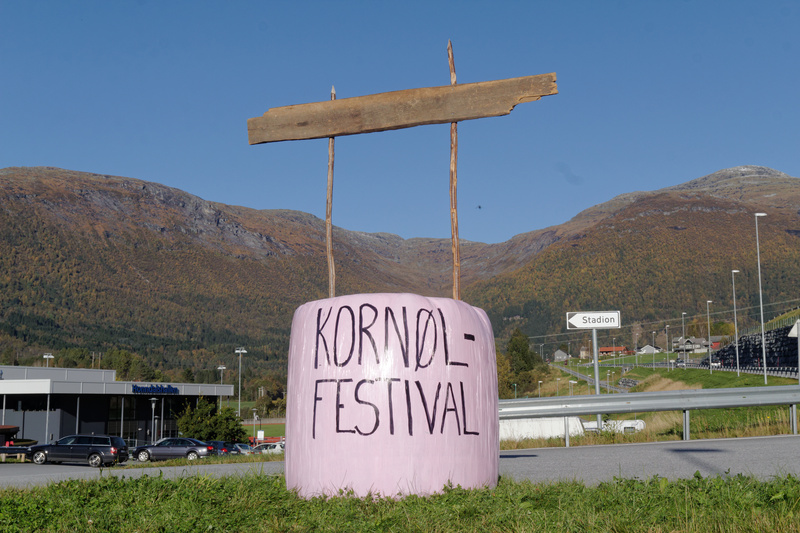
Festival sign, outside the sports hall venue |
Last year the first ever festival wholly dedicated to farmhouse ale (I think), Norsk Kornølfestival 2016, was held in Hornindal in western Norway. "Kornøl" is the local name for farmhouse ale, so the name really means "Norwegian farmhouse ale festival," and that's what it was.
The best kind of beer festival, I've found, is where the drinking public is at least as interesting as the commercial brewers and the speakers. And this was definitely that kind of festival. For one thing, farmhouse brewers are not like modern home brewers. They are country people, not hipsters or IT professionals. And the beer enthusiasts who travelled to the festival were not your average beer drinkers, either.
And then there were the locals, many of whom went to the festival because it provided a rare chance for a "night out" in a village that has no pub. They could have a couple of beers, chat with other locals, listen to some nice music, and maybe even dance a little. This mix of commercial brewers, farmhouse brewers, modern home brewers, beer history buffs, and random locals, was surprisingly enjoyable.
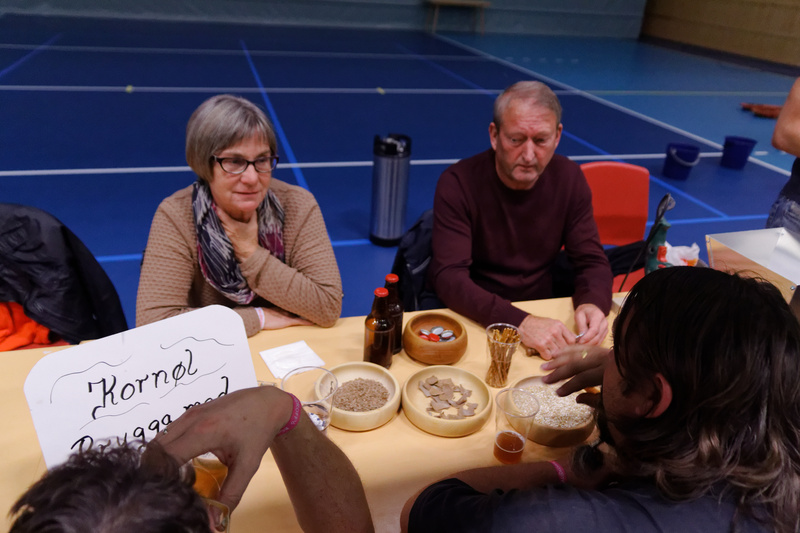
The Espe family, with bowls of kveik |
For me, the star attraction of the festival was without question the farmhouse brewers. Finding a farmhouse brewer used to take months of painful searching. Here there were 10 of them, all nicely lined up next to each other, ready to serve their beer and talk about it. Quite a few of them had even brought their kveik.
Except, as it turned out, since I was selling my book and doing a talk, I barely had time to talk to them, or taste their beer. I'm not complaining, because the people dropping by my table had lots of fascinating stories to tell. Many of them were farmhouse brewers who didn't bother serving beer at the festival, but still came by to taste the beers and talk to others.
One guy told me he had been a modern home brewer for over 40 years, but even though he lived in western Norway he'd only ever tried two farmhouse ales before coming to the festival. That tells you something about how amazingly obscure these beers have been. And now he'd tasted 12.
Another brewer, Jarle Nupen, dropped by to tell me the story of how he learned to brew kornøl in nearby Eidsdal in 1979. The old man who taught him brewing also gave him his kveik, "which I have watched like gold ever since." He happily gave me a sample, but unfortunately we're still waiting for the analysis results. He'd also tried modern ale yeast from a local craft brewery. "That stuff took 24 hours to get going," he said, shaking his head.
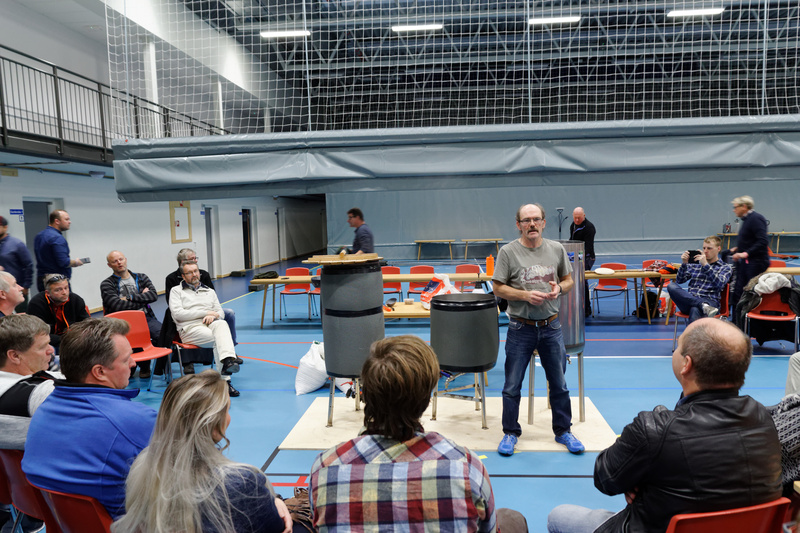
Demonstration brewing, Lars Andreas Tomasgård talking |
Then, suddenly, I was told I needed to judge the home brews as part of the offical judge panel. That was a real blessing, because now I was actually able to taste the beers. And, as so often, it was quite an experience. The farmhouse brewers were all from Hornindal, except one, and their beers had a clear family resemblance. They really all belonged to a single style, which I've called kornøl: pale, sweetish, fruity, low-carbonation, a good bit of sugar, raw ales, little hops, 6-8% alcohol (at a guess).
And then, in the middle of the sequence of blind-tasted farmhouse ales there was one that was deep dark red and powerfully smoky. It was impossible not to realize that this was a stjørdalsøl. And since there was only one of those at the festival, the brewer could only be Roar Sandodden. Knowing who the brewer was felt a little iffy, but there was no way to avoid it, since the beer itself gave it away.
One strange thing was that some of the kornøl were acidic, and some were not. I'd actually been warned about this, two years before, that some people in Hornindal not only brewed sour beer, but that they thought this was perfectly fine. Questioning the brewers afterwards I found that, yes, indeed, they saw no problem with the beer being sour. But Terje Raftevold would pour out his beer if it turned sour, so this was definitely not something everyone agreed on.
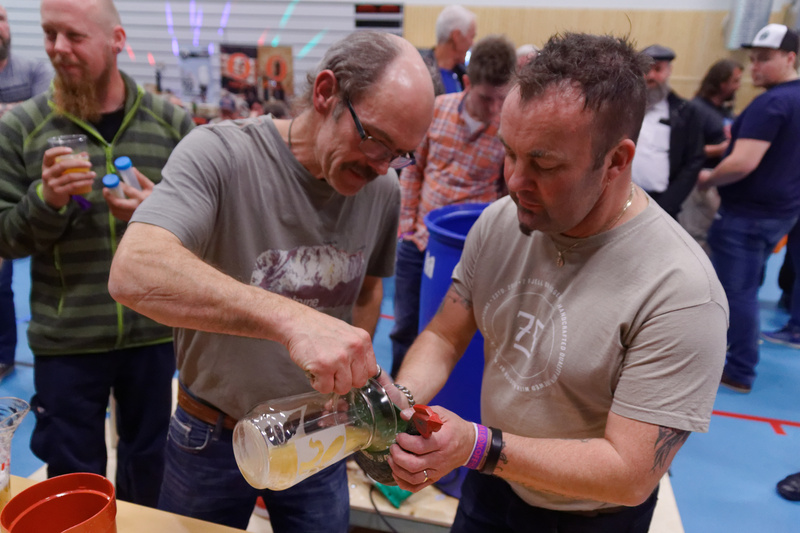
Lars Andreas Tomasgård serving kornøl to William Holden |
Before starting the judging the three of us decided we needed to set some ground rules, since none of us had ever judged a farmhouse brewing competition before. We decided that anything that tasted modern (high CO2, US-style hops, dark porter-type malts, etc) would be considered out of style, and penalized. We also decided that we couldn't very well tell the locals that we had decided sour farmhouse ale was necessarily wrong. Obviously the people actually living in the tradition would have to have the final word on this. So we decided to accept some acidity, provided it tasted subjectively good.
Top three entries:
#1: Larstunet bryggeri, consisting of Lars Andreas Tomasgård and one brewer whose name I never caught. Classic kornøl, with a lovely juniper aroma, and clear taste of boiled juniper, moss, and earth, with milky caramel and light touches of fruit and smoke. Hints of lemon, but no real acidity. A very good beer, and very easy to drink.
#2: Stalljen, brewed by Stig Stalljen together with a Håkon whose last name I didn't get, either. (I really need to take better notes this year.) Clear mushroomy juniper aroma. Acidic, again with that lemon hint, and the acid really emphasized the juniper and made it pop out in the initial flavour. Fresh juniper and wet forest type of flavour on top of the usual fruity raw ale flavours. Full body, despite the acid. (Note that this beer was acidic, not sour. pH 3.95.)
#3: William Holden. This was a rather unusual beer that wasn't like any of the others at the festival. Taste of peas, earth, and a good, bitter orange aftertaste. We noted that there was no clear raw ale profile, which isn't so surprising in retrospect, because William did boil the wort. So this was more of a modern type of kornøl.
The rest of the list had more kornøl, one stjørdalsøl, and some modern homebrews. Some of the kornøl were acidic, and not all of them in a good way. Of course, this happens with modern homebrewing, too.
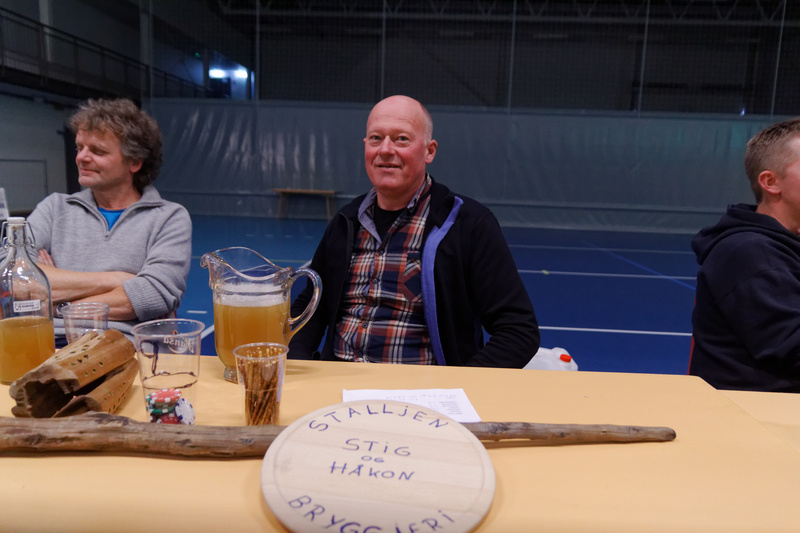
Stig Stalljen with a jug of beer. Rustesko on the left. |
The festival also had modern craft brewers serving their beers, and I have to admit that felt a little strange, since none of them were serving anything that was even close to a farmhouse ale. Nobody seemed to mind, though, and they were doing a brisk trade after the home brewers stopped serving. (Norwegian licensing regulations forbid selling commercial beer and giving away homebrew at the same time.)
This year the commercial brewers have to have at least one beer with at least one farmhousey thing about it (kveik, juniper, raw ale, ...) in order to participate. The good thing is that this year that's a requirement the festival can set, without winding up with only 2-3 breweries. That's actually quite a lot of progress in 12 months, if you think about it.
Anyway, for me, the highlight of the festival was the people I got to meet and talk to, and all the stories they had to tell. I talked a good bit with Ole Bjørn Ese, from Sogn, a boiled beer area, south of the glacier. He didn't brew, he said, but he was thinking of starting, so this festival visit was a kind of "industrial espionage," as he put it.
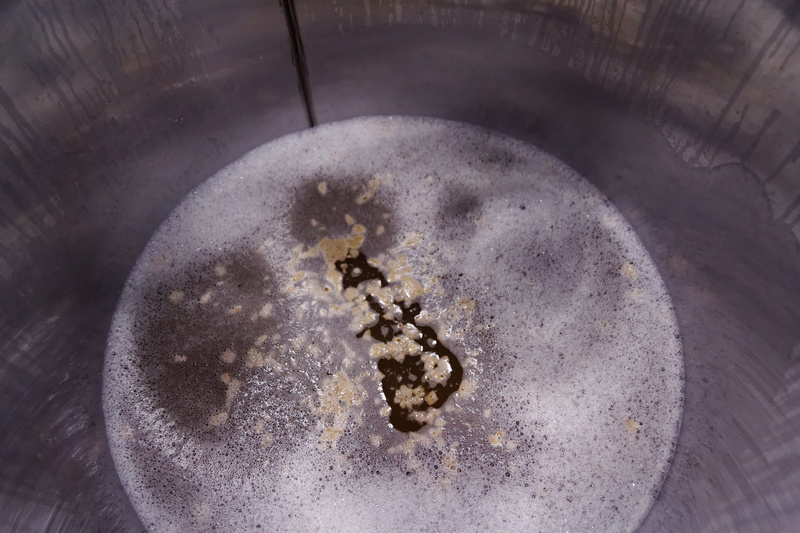
Kveik floating in the demonstration brew |
He comes from the small town Balestrand, where a couple of decades ago, there was only a single farmhouse brewer left. The brewer got cancer and realized he didn't have long left, so he announced to the village that if anyone wanted to learn the old-school brewing he was willing teach them, so that the brewing didn't die out.
The good news was that he got a volunteer. The bad news was that it was a woman. Reportedly, she was told that women in the brewhouse meant sour beer, so he wouldn't teach her. That may sound strange, but this is an ancient superstition in the area, and the brewer was entirely serious. The next day he regretted saying no, because he realized that either she was going to learn, or nobody was, so he decided to teach her, after all.
They brewed together twice. The second time the old brewer was so weak he could no longer stir the mash. That gives you some idea how important he thought it was. She really did learn, and I was told that she still lives in Balestrand, and still brews the traditional beer. That doesn't exactly mean the brewing is on a firm footing, so I hope Ole Bjørn has visited her and learned to brew from her so that more people can keep the local brewing tradition alive.
It was a good reminder of why this festival is important: these beers have one foot in the grave, and something needs to be done to prevent millennia of brewing tradition from dying out in the middle of the craft beer revolution. This festival is one of the things being done.
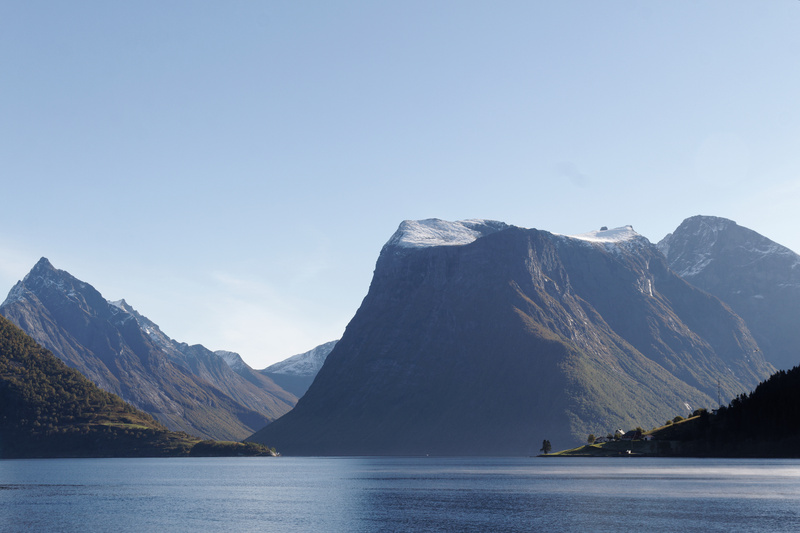
Nearby Hjørundfjord |
2017
There will be a festival this year, too, 29-30 September, in Hornindal. There will be farmhouse brewers serving their beers, commercial breweries serving farmhouse-inspired beers, talks, and demonstration brewing. This year there will two Lithuanians showing stone brewing a la Andrioniškis on the Friday, and stjørdalsøl brewing on the Saturday. There will also be a demonstration of Stjørdal-style malting.
The demo brew last year featured the famous yeast scream. Maybe we'll hear one this year, too.
If you're interested, see the festival home page. Hornindal is not the easiest place to get to, but the festival can help you arrange transport and a place to stay if you contact them on Facebook.
Full disclosure
I was shanghaied into being one of the organizers of this festival, so I may be somewhat biased. I've only been a minor figure in making it happen, though. It was really William Holden, who started the whole thing and did most of the preparations. He is from the region, but not from Hornindal. Physically making the festival happen was mostly taken care of by Ståle Raftevold and other people from Hornindal.
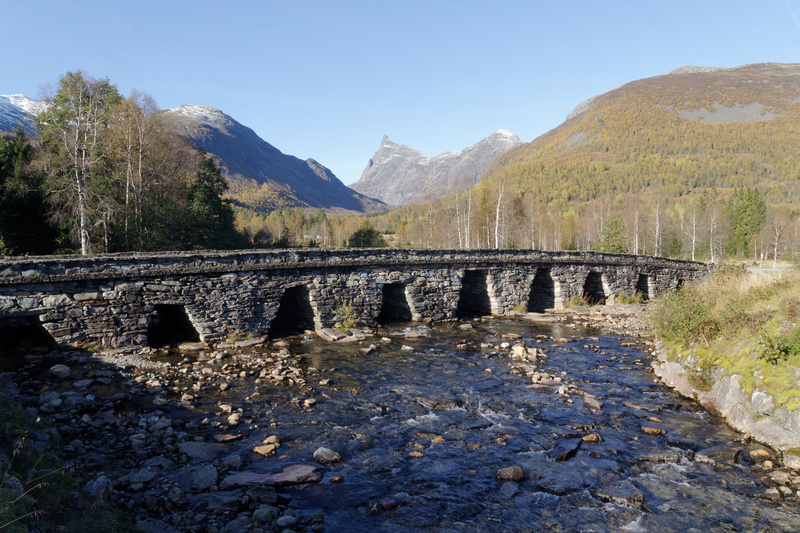
Horndøla bridge, higher up the Hornindal valley, with Hornindalsrokken in the background |
Similar posts
Farmhouse ale festival, now what?
Four years ago, back in 2015, William Holden told me that I was on the board for a beer festival in Hornindal to be dedicated to farmhouse ale
Read | 2019-06-14 16:43
Roaring the beer
The first time I heard about it was in Telemark (southern Norway), where Halvor Nordal said that one of his neighbours used to sometimes heat the beer very briefly in a saucepan before serving it
Read | 2018-04-21 22:45
Norwegian farmhouse ale styles
People are confused over what to call Norwegian farmhouse ale and what styles there are
Read | 2017-01-19 19:23
Comments
Martin Warren - 2017-08-13 21:54:43
I would love to visit the Hornindal festival but unfortunately it clashes with a traditional knitting (Gansey) symposium that I sm speaking at. I look forward to the 2018 fest with interest. I hope this year's is a great success.
Alec - 2017-08-18 17:26:17
A lot of the men in those images DO look like hipsters. So maybe there's something about brewing experimental beer that naturally leads to that - craft brewers have been genetically turning into Scandinavians this whole time we just didn't realise it! Seriously, though, that passage about the man not wanting to teach a woman because would make the beer sour will stick in my mind. I love reading these posts when everything else is about London and Manchester (not that there's anything wrong with them).
Jason - 2017-10-25 14:15:20
I saw Kornĝlfestival and immediately though Corn Hole Festival :)